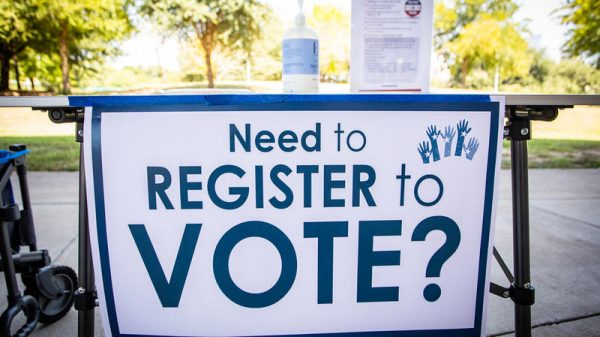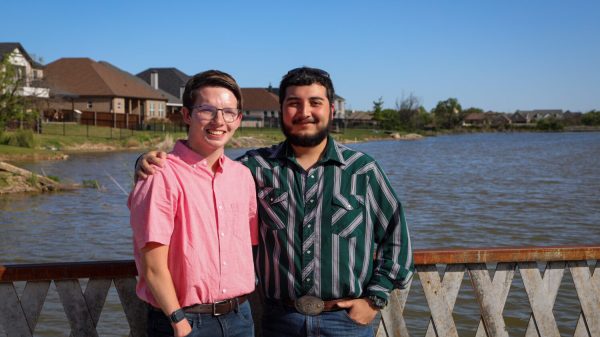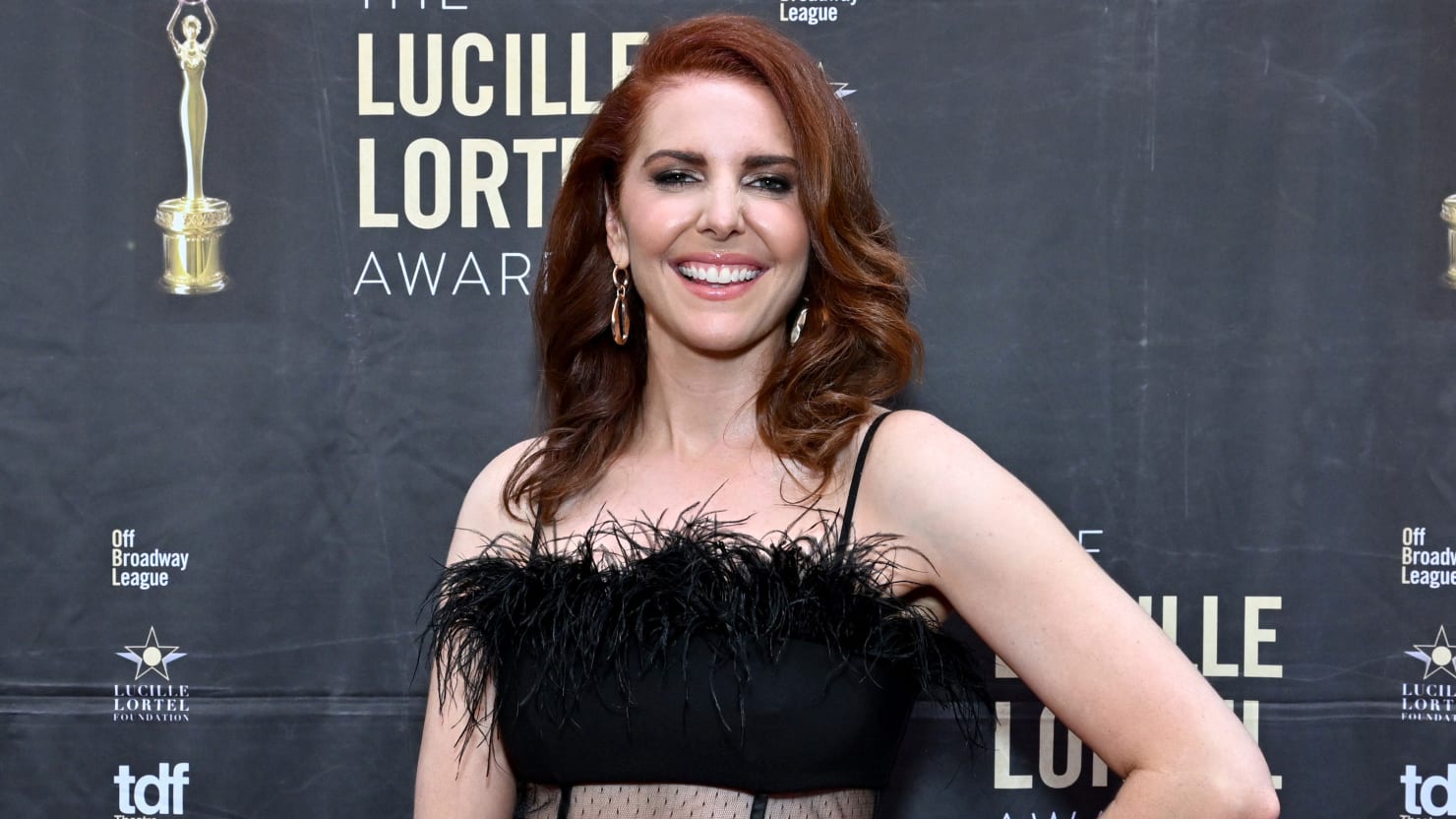Like many things that can be described as big and gay, The Big Gay Jamboree owes much to Céline Dion.
For a full year—and in fits and starts for a stretch of time before that—Marla Mindelle, who co-wrote and stars in the buzzy new musical The Big Gay Jamboree, was Céline Dion.
Each night, she’d don a blonde wig, zip up a sparkling gown, slip into a cartoonish French Canadian accent, and belt to the heavens in the delightfully deranged musical Titanique, which she also co-wrote. The show earned a cult following that morphed into a mainstream obsession, leading to its transfer from a theater space in the basement under a closed Gristedes grocery store to a bonafide off-Broadway theater near Union Square, where it continues to extend its run.
The show is a fever dream, reenacting the events of the film Titanic with the conceit that Céline Dion herself was aboard the ship, narrating to the audience her memories of Jack and Rose while singing hits from Dion’s repertoire. Critics hailed the piece as a masterpiece of stupidity, a show so smart in its approach to utter absurdity that it transcends to the best version of high art: the kind that you can’t believe exists, and that makes you wonder what exactly is going on in the brains of the people who created it.

One night just over a year ago, she was performing the song “Taking Chances” and dancing across the stage doing a ridiculous, hammy air guitar, and was struck by a woman in the audience’s smile. “I was like, that’s the most beautiful woman I’ve ever seen,” she tells me, in a recent interview at a café in the East Village. “And then I was like, ‘Holy f—ing s–t, that’s Margot Robbie.”
From there, The Big Gay Jamboree was born.
The Big Gay Jamboree is Mindelle’s next project, an original musical, produced by Robbie, opening Monday night off-Broadway at the Orpheum Theater.
The show is a continuation of the path that Titanique set her on. Titanique wasn’t just a critical and commercial success. (Mindelle won the Lucille Lortel Award for Lead Performer in a Musical, and there are productions of Titanique now being staged in Australia and Canada.) It was proof that humor that was once deemed too niche, too “inside baseball” about musical theater, and, frankly, too gay didn’t just serve that target audience—who lapped it up along with the sippy cups of wine at their seats—but had a mass appeal.
“That was the thing that I was the most shocked about,” Mindelle, who identifies as queer, says. “I was like, this is written for gay millennials and gay millennials only. No one else is gonna get it. And I’ll never forget, a 70-year-old woman came up to me after the show one day. She was like, ‘I hate musicals. I hate Céline Dion. I love this show.’ I was like, ‘Well, why are you here?’” She laughs. “But I’m hoping that the same thing happens with Big Gay Jamboree.”
Margot Robbie certainly thinks it will.
The day after Mindelle clocked Barbie herself at the Titanique performance, an email appeared in her inbox. The subject line was, “Hey, it’s Margot.”
“I was like, this is a f—ing scam,” Mindelle remembers. “I told my sisters, and they were like, don’t open it. Somebody’s asking for money.” Mindelle took the risk. She had to. This email is the kind of kismet that, well, people write musicals about. Because, you see, this wasn’t the first time Mindelle and Robbie’s paths had crossed.
Ten years ago, Mindelle, who is 40, left musical theater. “I was like, peace out, I never want to do this again. I’m gonna go make it as a writer,” she says. “And God was like, lol, I have other plans for you: You’re gonna fail miserably.”
She and her writing partner, Jonathan Parks-Ramage, moved to Los Angeles. They had a shared love of old Hollywood musicals, and thought, if we like these musicals so much, maybe we should write one. And so they wrote the first version of The Big Gay Jamboree, in which a modern woman wakes up to find herself trapped inside an old-fashioned musical and must endear herself to the townspeople—all various versions of Rodgers and Hammerstein archetypes—in order to, through the power of song and rousing choreography, find her way back to real life.
It had gotten into the hands of Robbie and her production company, Lucky Chap, and they loved it. “Then it went into what is known as movie development hell, which is where projects live or die—and mostly die,” Mindelle says.
“Seven years later, the only thing that I had in Los Angeles was this rinky-dink show that I was writing with my friends called Titanique,” she continues. The show originated out of a drunken conversation with her friend, Constantine Rousouli. Their other friend, Tye Blue, who they knew through performing musical adaptations of movies like Cruel Intentions at dinner theaters, loved the idea and would end up producing and directing. “I was like, this will never f—ing go anywhere. And it becomes this huge hit.”
It became such a huge hit that Margot Robbie, a huge Céline Dion fan, bought a ticket to see it and, after, wanted to collaborate with Mindelle.
That email from Robbie said, “Titanique was the greatest thing I’ve ever seen. Are you working on anything else?” Mindelle mentioned the movie musical that they had been working on together eight years ago; there’s something there that she’d like to revisit as a stage production. “She was like, ‘When do you want to do it?’” Mindelle says. “I was like, literally, tomorrow, because I don’t have much time left in this business. And she was like, ‘OK.’”
Mindelle looks out the café window across the street to the Orpheum Theater, where her face is on The Big Gay Jamboree poster and previews were in full swing ahead of opening night. “And that was literally a year ago.”
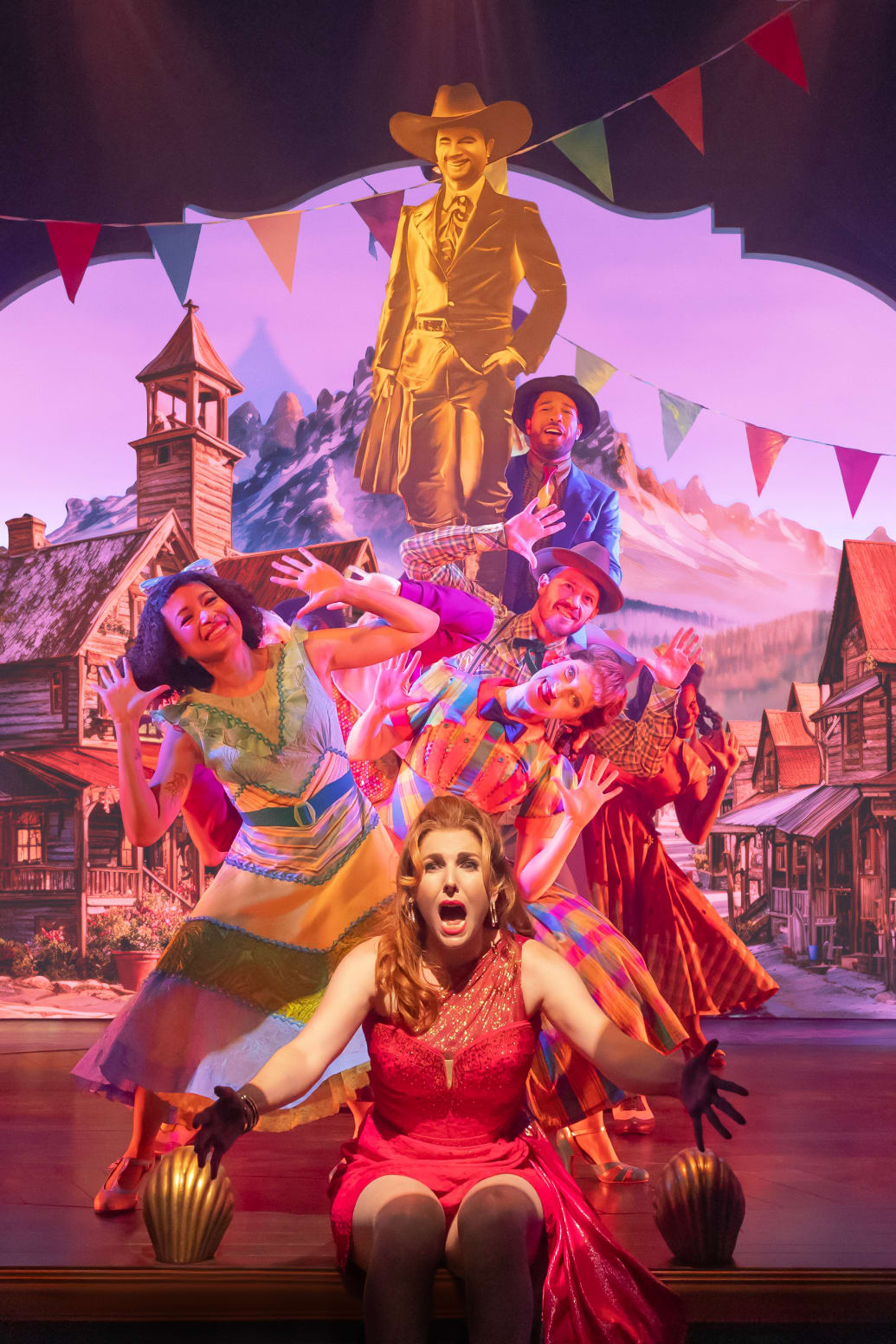
Marla Mindelle and the cast of The Big Gay Jamboree
Matthew Murphy
Now, with Titanique an international smash and The Big Gay Jamboree set to open, Mindelle has become somewhat of an It Girl of New York theater. Her name and her projects carry weight, along with a promise of the kind of material and humor once ignored that could be commercially successful.
You can walk from Union Square, where Mindelle as Céline in Titanique is plastered outside the Daryl Roth Theater, to the East Village, where her face is wallpapering the Orpheum in The Big Gay Jamboree, and see multiple posters of her along the way. “I consider myself the queen of trash,” she says, “because my face is on trash cans all over New York City. I feel like that’s so apt for me.”
No one tells you how hard it is to say goodbye to your baby. Especially if your baby is Céline Dion.
“It’s like Moses, and you just put it in the river and let it drift,” Mindelle says, when we start talking about what it was like to step away from Titanique last June after so many years of developing it and watching its impact grow. “I was really grieving.”
“When we first started doing it, Ty went into debt with $10,000 on his credit card,” she remembers. “I was renting my Céline dress from Rent the Runway. I bought my Céline wig on Hollywood Boulevard for $75. Connie was a gay wizard. He made all the props. It was unique in the sense that it was this tiny thing.”
“Watching it blow up with my best friends and having people laugh for 90 minutes, it was the greatest gift of my life,” she continues. “It changed my life. But then doing it for a year and being tired and saying that I need to move on…no one really tells you what that experience is like.”
She would walk through Central Park every day, and she would cry. There was one day that she looked up at the sky and begged for something to distract from how sad she was feeling. A week later, Robbie’s email landed in her inbox: “So…God delivered!”
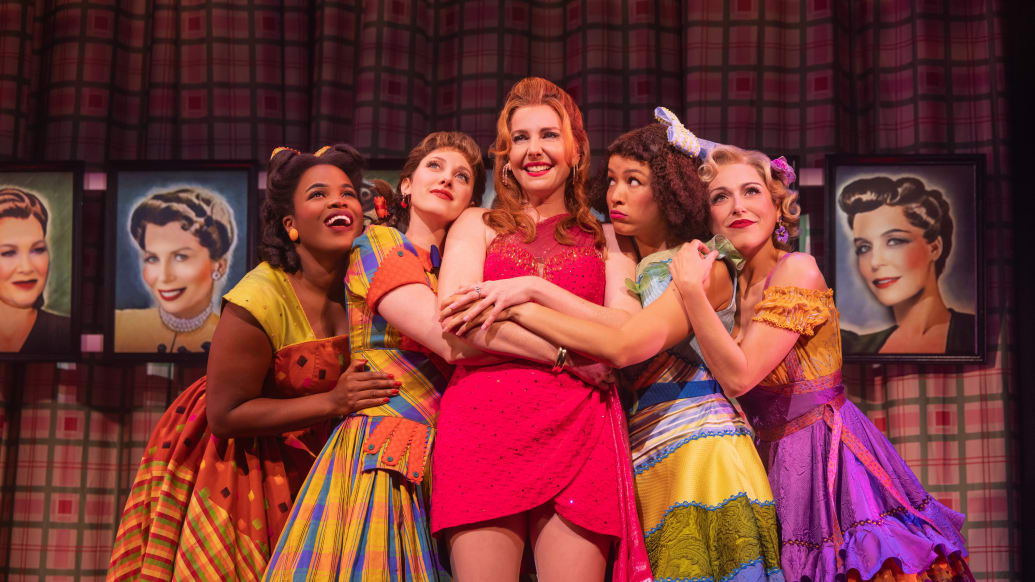
Marla Mindelle and the cast of The Big Gay Jamboree
Matthew Murphy
In doing Titanique, she learned that there are absolutely no rules when it comes to making musical theater, one of several lessons she held close while working on Big Gay Jamboree: “Also, audiences are smart. They’re also much more niche than I thought, and they’re much gayer than I thought.”
When Titanique began, the Heart of the Ocean necklace was made out of cardboard and garland that was bought at Michaels. The movie’s legendary car sex scene was recreated using a Fisher Price toy car. A Barbie was used for the sequence where a passenger falls off the sinking shop and hits a propeller. A RuPaul’s Drag Race Lip-Synch for Your Life dance-off determined who gets to a spot on a lifeboat. The iceberg was anthropomorphized, becoming a character referred to as the “Iceberg B—-,” who looks and sings like Tina Turner. Again, this was a musical version of Titanic in which Céline Dion was a passenger.
The Big Gay Jamboree is as proudly, profoundly, utterly, and gloriously stupid. But this time, it’s stupid with a budget.
There are real sets. Scrims fly up and down from the rafters. The stage has an actual turntable. It marks a graduation of sorts not just for Mindelle and her collaborators, but for the brand of off-kilter comedy that they thrive in—a call up to the major leagues, if I were to insult a feature about a musical called The Big Gay Jamboree by employing a sports metaphor that a straight person would use.
There is pressure that accompanies a gamble like this one. This is no longer the absurd, small thing that started in the basement of a Gristedes. It’s, as its title suggests, bigger. It’s gayer. It’s a test as to whether the vote of confidence given to Mindelle and the audience that championed Titanique will pay off.
The Big Gay Jamboree begins with Mindelle’s character, Stacy, waking up hungover on a strange technicolor set while women dressed in corsets and frilly skirts claiming to be her sisters sing and dance around her. She looks out at the audience and mouths, confused, “What the f—?”
“It’s like this weird M. Night Shyamalan movie, where she wakes up and she feels like she’s being human trafficked by a bunch of smiling people in a musical,” Mindelle says. “She has no idea how she got there, and she has to figure out how to get out. So it’s kind of like this f—ed up Wizard of Oz, where she’s trying to convince these people that they are trapped in this musical with her, and she’s got to get them to the other side. She’s got to get to the future. So it’s kind of like woke Dorothy at the helm of it, trying to lead these people out of this musical.”
Stacy, for example, introduces herself to her new “sisters” by singing a Dear Evan Hansen-inspired power ballad about her dream to be a Real Housewife—just not on the inferior Dubai franchise. A crowd-pleaser where her sister Flora (Natalie Walker) embraces her intense horniness is modeled after the Marilyn Monroe number “Diamonds Are a Girl’s Best Friend” from Gentlemen Prefer Blondes. When she stumbles upon a man in the woods named Bert (Titanique’s Rousouli), she instantly recognizes him as a gay who doesn’t even know that homosexuality exists. She sings him a version of Maria Von Trapp’s “Do Re Mi” from The Sound of Music, but all with gay lexicon that would make us blush too much if we typed them out here.
Think of The Big Gay Jamboree as a musical with nostalgic bones, but modern humor as dressing. Like if Harold Hill from The Music Man knew what poppers were, or if Curly and Laurie’s happily ever after in the years after the events of Oklahoma! involved hate-watching The Bachelorette. Imagine going to a production of South Pacific, and Nellie Forbush starts recording a TikTok with her opinions on Chappell Roan.
“Inherently, a lot of these classic musicals have very, very racist or misogynistic or homophobic tropes,” Mindelle says. “It’s been very fun for us to dismantle that in a funny and charming way.”
She’s somewhat of an expert on the genre. “I literally popped out of the womb with jazz hands,” she says.
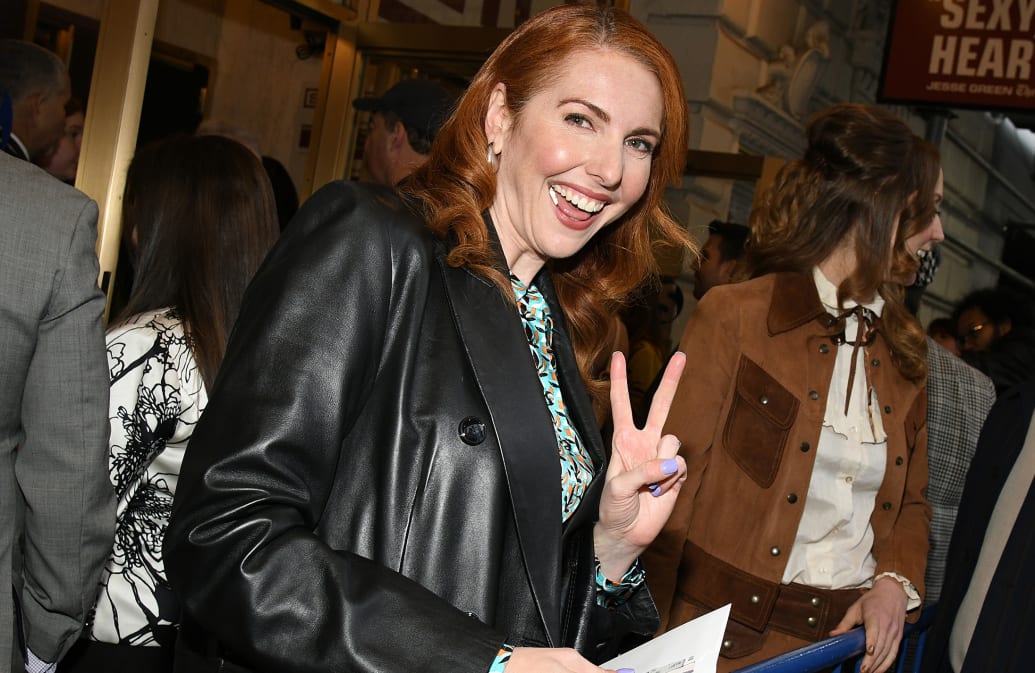
Marla Mindelle at the opening night of Broadway’s Stereophonic
Kristina Bumphrey/Variety via Getty Images
Movie musicals like Seven Brides for Seven Brothers, The Sound of Music, and Mary Martin’s Peter Pan were on constant repeat in her house. She grew up in Pennsylvania in a musical family. Her dad was a composer. He and her mother met while doing a regional production of 110 in the Shade in Arizona. Mindelle remembers taking the train to New York as early as 3 years old to see The Phantom of the Opera and The Secret Garden on Broadway. “It’s the greatest art form,” she says. “I love old-fashioned musicals. It’s in my DNA.”
It was predestined that she would study musical theater in school, which she did at the University of Cincinnati College-Conservatory of Music. There, she met her Big Gay Jamboree co-creators, Parks-Ramage, Philip Drennen, and Connor Gallagher.
“We went through what can only be described as gay prison.”
“We went through what can only be described as gay prison,” Mindelle says. “Being in musical theater programs, you were just stuck there in the war camps singing Jason Robert Brown songs at 18 years old, being like, ‘Get us out of here. We can’t wait to do theater.’”
Mindelle’s first professional job was on the first national tour of The Drowsy Chaperone. She was in the original Broadway casts of Sister Act and the 2013 revival Rodger and Hammerstein’s Cinderella.
“In my twenties, I was like, I can do no wrong. I’m the best person on the planet. I’m going to do Broadway for the rest of my life,” she says. “I got very humbled by life. I think that my twenties were actually very, very great. My thirties were, until Titanique, just a mess.”
Failure, it turns out, can be a uniting, powerful creative force, especially when you channel it into making your own content. That’s what worked when Mindelle, Rousouli, and Blue licked their wounds after struggling in LA and took a bet on Titanique. “In that same way,” Mindelle says, “I think Big Gay Jamboree is successful because it’s from people that have the same deranged brain and the same shorthand of language after 20 years of shared history.”
The poster advertising Big Gay Jamboree touts that it’s “from the producers of Barbie and the delulu creator of Titanique,” cheekily using a modern shorthand for “delusional.”
“I’m very, very open about my deep, deep musical theater mental illness,” Mindelle says. “I love it so much. I hate it at the same time. It causes me a lot of anxiety, performing.” She relishes that, in two shows now, she’s gotten to express her love for musical theater, while also brutally making fun of the artfrom. And “delulu,” she says, is a label she proudly owns, “because that is a true crown.”
“I’m very, very open about my deep, deep musical theater mental illness.”
Each night before curtain, the Big Gay Jamboree cast does breathing exercises and a warm up. As a pep talk, one of the cast members says, “We’re all losers for doing this. And everyone who’s watching it is a loser too for loving it. Just go out there and have some fun.”
Mindelle laughs. “I feel like I am such a troll in my life, like that is my love language,” she says. “So to actively troll myself in a musical is the greatest justice.”
One of the more unsettling things that she’s had to adjust to amid her recent success is how to rectify her cynicism—her self-identifying troll nature—with an earnestness and almost spiritual appreciation for what’s happening.
She tells me a story about one of those days after leaving Titanique when she was crying while walking through Central Park, wishing for something to take her mind off the grief. Right after, she and Rousouli were invited to audition for Saturday Night Live. The day after they weren’t cast is when she got an email from Robbie.
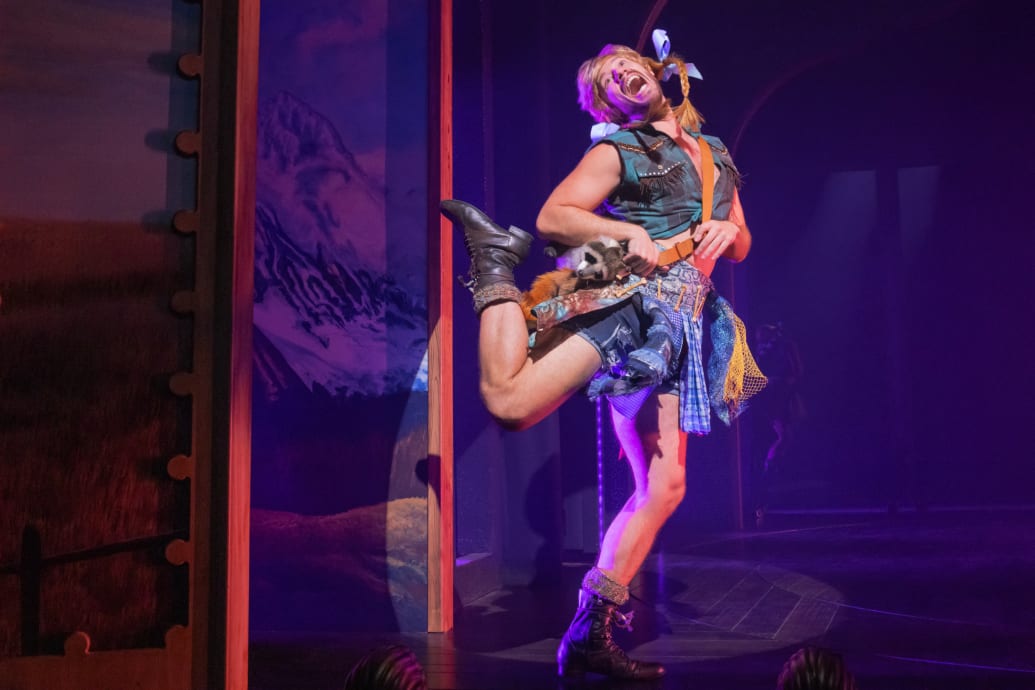
Constantine Rousouli in The Big Gay Jamboree
Matthew Murphy
Mindelle auditioned with her Céline Dion impression, and did takes on Idina Menzel and Christine Baranski. (“Very niche.”) She sang the gay “Do Re Mi” number from Big Gay Jamboree as Julie Andrews, and even got to do some material with Rousouli. Afterwards, Lorne Michaels introduced himself to them as a fan.
To celebrate their audition, they got super drunk at the Brasserie St. Marc on Second Avenue—two blocks from the Orpheum Theater where, exactly a year later, they would begin previews for The Big Gay Jamboree. “It’s just so full circle. I’m so grateful.”
It goes without saying that Mindelle, at this point, is exhausted. She has to run from our coffee meeting to rehearsals to tweak some numbers before that night’s previews. It’s not easy writing a musical in which the leading lady almost never leaves the stage and belts notes higher than the theater’s rafters multiple times a night—and then also play the part of that leading lady.
“I’ve got to stop doing this to myself,” she says, thinking about her next venture. “I keep saying to everyone, this is my Eras Tour. This is my farewell tour. After this I’m gonna rest easy. The next musical I write, I hope to maybe take a back seat.”
“At the same time, it’s exciting,” she continues. “I just figure, if this is it, then I’m gonna go out with a bang.” Once again, she laughs: “I’m talking to you as if I’m dying after this.”
She’s not dying. She’s just doing musical theater.




![Tyson Foods Plant [Photo: Food Manufacturing]](https://southarkansassun.com/wp-content/uploads/2023/08/iStock_1185520857__1_.5e441daa51cca-600x337.jpg)








![Silverado Senior Living Management Inc. [Photo: Los Angeles Times]](https://southarkansassun.com/wp-content/uploads/2023/10/download-6-4-600x337.jpg)

![China's Wuhan Institute of Virology [Photo: Nature]](https://southarkansassun.com/wp-content/uploads/2023/09/d41586-021-01529-3_19239608-600x337.jpg)








